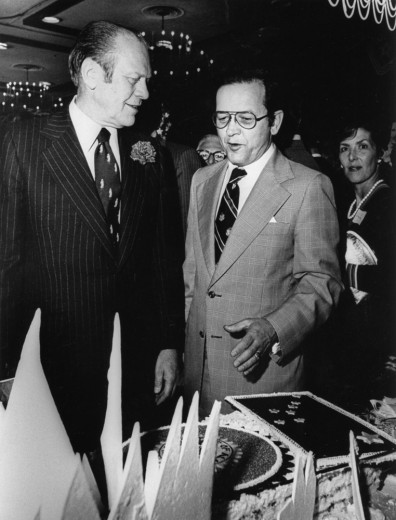The Laxalt Cabinet and Staff
President Paul Laxalt (NV, Conservative Republican, Hawk)
Going into the 1984 election, President Laxalt feels he has done the best he could have with the hand he was dealt. Having passed conservative economic stimulus, Laxalt is at odds with the Democratic controlled Congress on exactly how to end what the media is calling the Great Recession. On top of that, Laxalt's discontinuation of pork barrel spending and guaranteed employment has caused a rift between the party's more traditional conservatives on one side, and the Rhodesite conservatives and moderates on the other. Laxalt hopes to unify the party at the Republican National Convention, win election in his own right, and define the 1980s as the decade of conservatism.
Vice President Richard Nixon (CA, Moderate Republican, Realpolitik)
Nominated by President Laxalt and voted into the office by Congress, Richard Nixon is the longest serving Vice President in American history. Representing continued stability in the Laxalt Administration, Nixon has kept his head down with the schism between Laxalt and the Rhodesites. Nixon still holds significant sway over foreign policy, but not nearly to the extent of his time as Secretary of State during the Rhodes Administration. Nixon is determined to stay in the presidential administration, and is entirely willing to play both sides to guarantee it.
Secretary of State Henry Kissinger (MA, Moderate Republican, Realpolitik)
Part of the agreement between Laxalt and Nixon to move from the State Department to the Vice Presidency was that Nixon's ally, National Security Advisor Henry Kissinger, would become Secretary of State. Kissinger is seen as a proxy of Nixon's, and continues to support Nixon's foreign policy objectives, such as Iraq's invasion of Iran, and supporting anti-Soviet dictatorships around the world. For the time being, these are also the goals of President Laxalt.
Secretary of Treasury Claude R. Kirk Jr. (FL, Conservative Republican, Hawk)
Claude Kirk is the only prominent Rhodes loyalist who has remained in the Laxalt Administration. Kirk was instrumental in passing Laxalt's economic stimulus plans to address the Great Recession. Kirk is still a major proponent of Rhodes-style liberal corporatism, and is the only remaining voice from within the cabinet still actively calling for the
Jobs For America Act.
Secretary of Defense Barry Goldwater (AZ, Conservative Republican, Hawk)
With Laxalt in the Oval Office, former Senator Barry Goldwater has been re-appointed as Secretary of Defense to replace Alexander Haig. Goldwater had served as Rhodes' Secretary of Defense in his first term, but was replaced by Haig going in to Rhodes' second term. Goldwater was chosen both for his close ties to President Laxalt, and because Congressional Republicans couldn't afford to lose one of their ranking members while already being in a weak position.
Attorney General Bill Saxbe (OH, Moderate Republican, Dove-Leaning)
Bill Saxbe was one of the Rhodes cabinet members who stayed on into the Laxalt Administration for the sake of unity and continuation following the Rhodes Assassination. Saxbe has been encouraged by Laxalt to continue enforcement of the War on Drugs, a program the Attorney General is increasingly concerned is going beyond its mission statement and legal responsibilities.
Secretary of the Interior Don Samuelson (ID, Conservative Republican, Hawk)
Samuelson is another member of Rhodes' cabinet who has stayed on with Laxalt. Samuelson follows Rhodes' (and Laxalt's) philosophy of resource extraction projects and an expanding industrial economy.
Secretary of Agriculture William R. Poage (TX, Conservative Democrat, Hawk)
William Poage intended to retire at some point in Rhodes' second term, but his plans were thrown into chaos following the Rhodes Assassination and resignation of several other cabinet members. The aging Agriculture Secretary is bound by his sense of duty to stay on the cabinet with many of its members resigning in protest of Laxalt's policies, and is half-heartedly going through the rest of the term.
Secretary of Commerce Dave Thomas (OH, Conservative Independent, Realpolitik)
Dave Thomas, like Poage, is antsy to leave the cabinet, but has stayed on out of a sense of responsibility. The Founder of Wendy's, Dave wants to get back to his burgers, and re-enter the private sector at the soonest possibility, especially with the Great Recession hurting all businesses.
Secretary of Labor Thomas Watson Jr. (CT, Moderate Independent, Realpolitik)
The retired President of the International Business Machines Corporation (IBM), Thomas Watson revolutionized the computer industry, developing hardware and software, and reaping the rewards in early investments into the idea of office computers. Watson also divided the company into different divisions in a decentralizing move that allowed for much greater logistical flexibility and specialization of sales. Watson replaces Jacob Javits as Secretary of Labor, who resigned in protest along with fellow cabinet members Alexander Haig, Charles Percy, and Hyman Minsky.
Secretary of Health, Education, and Welfare Robert H. Michel (IL, Conservative Republican, Hawk)
Another Rhodes appointee who has stayed on, Michel is one of the few members of the cabinet who prefers the policies of the new President to the late one. Having been used as the hatchet man by the Rhodes Administration for years, Michel is thankful the pure hatred and vitriol he's gotten is now mostly directed towards the President.
Secretary of Housing and Urban Development Edward Brooke (MA, Rockefeller Republican, Hawk-Leaning)
The former Senator for Massachusetts as well as that state's first African American Senator, Edward Brooke co-wrote the
Fair Housing Act along with Democratic Senator Walter Mondale. Later, he would call for stronger enforcement and provisions of the act. Brooke was also a supporter of many prominent Great Society programs, but was cautious of McCarthy's more stringent Crusade Against Poverty. Although convinced of guaranteed employment by the Rhodes Administration, Brooke has joined the Laxalt Administration to replace Jacob Javits, who resigned in protest of
Jobs For America not being enacted.
Secretary of Transportation Ray Lee Hunt (TX, Conservative Republican, Hawk)
Ray Lee Hunt, the famous oil tycoon, has stayed on as Secretary of Transportation. With Laxalt now the President, Hunt is more in agreement with the Oval Office when it comes to opposing unions and unionization, and has been given a freer hand to help legislate 'right to work' laws. Hunt has particularly targeted the Teamsters.
Secretary of Employment Milton Friedman (IL, Libertarian Republican, Realpolitik)
The well-known Chicago School economist Milton Friedman is the second man to hold the title of Secretary of Employment. A laissez-faire capitalist and enemy of Keynesianism, Friedman is not a supporter of guaranteed employment. Rather, Friedman supports deregulating the economy and instituting a flat tax rate and negative income tax (among other policies) to promote economic growth and private sector employment. Friedman has described himself as a Classical Liberal, and a Republican for reasons of expediency rather than principle.
------------------------------------------------------------------
Supreme Allied Commander Europe Bernard W. Rogers (KS, Moderate Independent, Hawk)
Bernard Rogers has been working for the past few years to whip the United States Army back into shape after low funding and lower morale in the 1970s. Rogers has returned America to previous stance of military readiness, and preparedness for confrontation with the Soviet Union in Europe.
Director of the Federal Bureau of Intelligence Mark Felt (DC, Conservative Independent, Hawk)
The successor to the legacy of J. Edgar Hoover, Mark Felt has fully cooperated with the hawkish foreign policy of Rhodes, Nixon, and Laxalt, though the purview of the FBI remains largely in domestic affairs. Felt has kept his head down compared to Hoover, and has attempted to improve the image of the FBI following the McCarthy Presidency, where the FBI was threatened with abolition before the McLaughlin Scandal. The FBI, and America's other secret services remain largely unaccountable organizations, but Felt has done a much better job of collaborating with Congress and the President in exchange for making sure things stay that way.
------------------------------------------------------------------
First Lady Carol Laxalt
Despite becoming First Lady under tragic circumstances, Carol Laxalt has made the best of it. Carol frequently holds White House events, and is a much more public and well known figure than First Lady Helen Rhodes. Carol remains in close contact with the Rhodes family, although invitations over to the White House for family and friends dinners have been declined.
White House Chief of Staff Tom Loranger (NV, Conservative Republican, Hawk)
Tom Loranger was Paul Laxalt's Chief of Staff back when he was just the Senator for Nevada. Loranger continued in the same role as the Vice President's Chief of Staff, and now serves as White House Chief of Staff. Loranger has had the unenviable task to wrangle the transition from a White House staff that had been entirely transplanted from Ohio, to one that more reflected Nevada and Washington D.C.
White House Senior Advisor Wayne Pearson (NV, Conservative Republican, Hawk)
Wayne Pearson has served as Paul Laxalt's senior campaign advisor since Laxalt's incredibly narrow loss to Howard Cannon in Nevada's 1964 Senate election. Pearson continued to advise Laxalt during his successful runs for Governor of Nevada, Senator for Nevada, and his later upstart primary challenge for the Vice Presidency.
White House Press Secretary Ronald Reagan (CA, Conservative Republican, Hawk)
The former Governor of California and three-time presidential contender, Ronald Reagan has been a stalwart supporter of his good friend Paul Laxalt, before his becoming President and afterward. The irony is not lost on Reagan that he was a strong supporter of Laxalt's vice presidential campaign in 1980, only for Laxalt to become President from it later. Referred to as the "First Friend," Reagan was chosen as press secretary following the Rhodes Assassination in the hopes that his sunny disposition would allay fears. Although some have begun to question his mental faculties, Reagan fully intends to stick by Laxalt through thick and thin, a sentiment the President has returned.
White House Chief Speechwriter Pat Buchanan (VA, Conservative Republican, Isolationist)
The career of Pat Buchanan has been closely tied to that of Richard Nixon. Working as a speechwriter and opposition researcher for the Nixon campaign in 1968, Buchanan returned to writing editorials after Nixon lost, but returned to working for Nixon in 1977, when Nixon became Secretary of State. Buchanan was the leader of the 'White House Gardeners,' a group of smear merchants and opposition researchers organized by Nixon at the behest of President Rhodes during his 1980 re-election campaign. Now, with Nixon having moved to the Vice Presidency and with an aligning ideology with President Laxalt (except in the realm of foreign policy), Buchanan has been appointed as Chief Speechwriter.
Director of the Council of Economic Advisors Alan Greenspan (NY, Libertarian Republican, Hawk)
A long-time Wall Street investor and corporate executive, Alan Greenspan is a proponent of monetarist policies, Chicago School economics, and a laissez-faire, free market capitalist system. Like many members of the Rhodes and Laxalt Administrations, Greenspan has long-standing ties to Nixon, but is politically more aligned with Laxalt than the now-Vice President.
National Security Advisor Brent Scowcroft (UT, Moderate Republican, Realpolitik)
An associate of Henry Kissinger and the previous Deputy National Security Advisor, Brent Scowcroft has moved up to the position of National Security Advisor while Kissinger has become Secretary of State. Often overshadowed by Nixon and Kissinger, Scowcroft is a less well-known, if effective, foreign policy specialist. Scowcroft is also more considerate of national sovereignty than Nixon and Kissinger, and is somewhat more akin to Democratic foreign policy specialist Zbigniew Brzezinski.
Director of the Environmental Conservation Agency James G. Watts (WY, Conservative Republican, Hawk)
One of the most controversial members of the Rhodes and Laxalt cabinets, James G. Watts has almost entirely eliminated the Agency that he has been running for the last seven years. The Environmental Conservation Agency no longer exists, for all intents in purposes, and acts more as a toothless environmental lobbying group than a government organization that enforces regulations.




